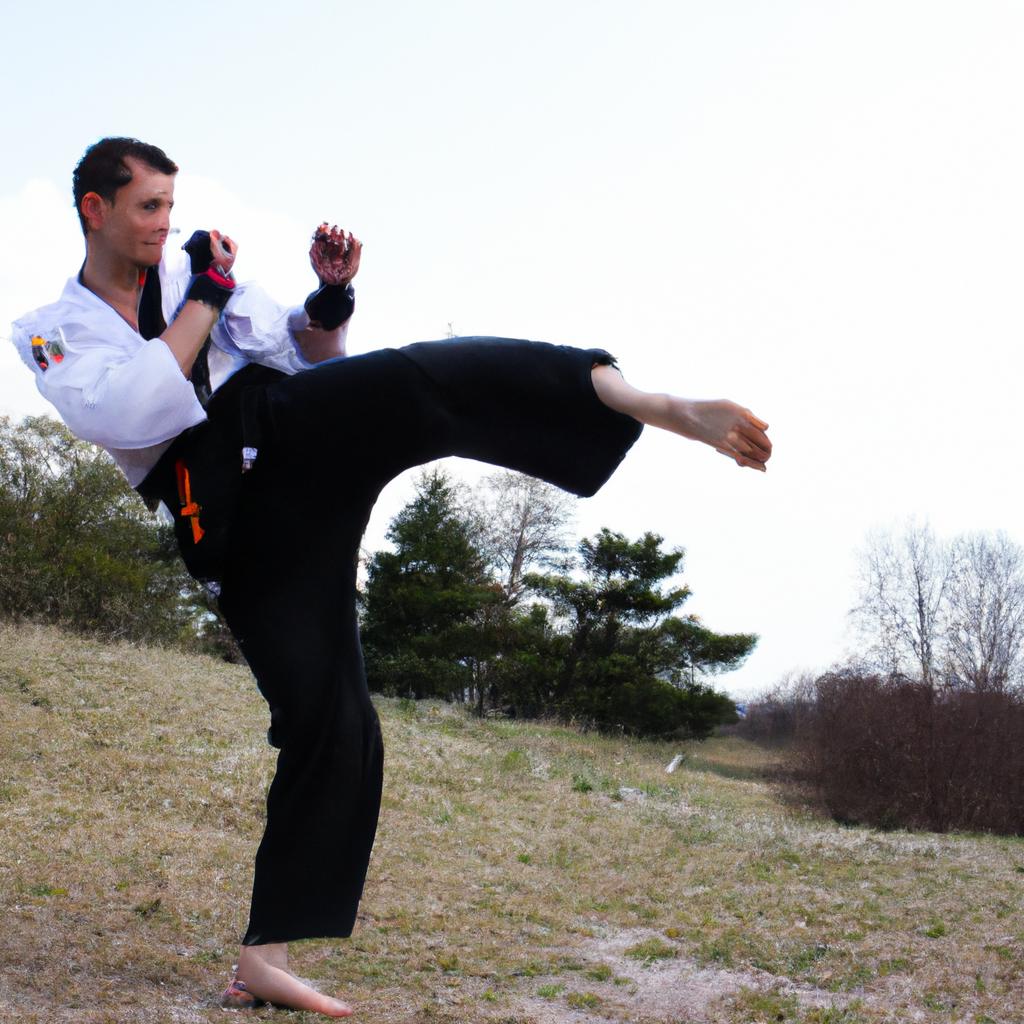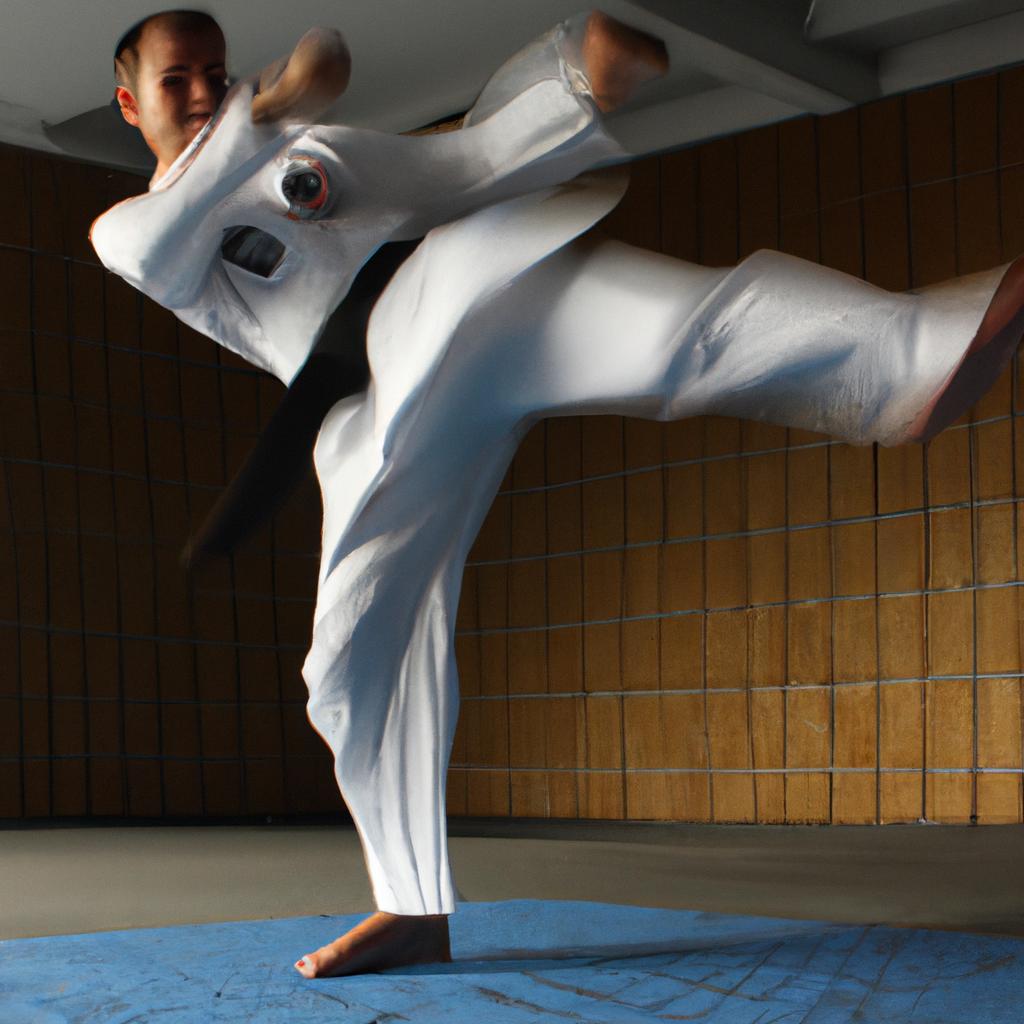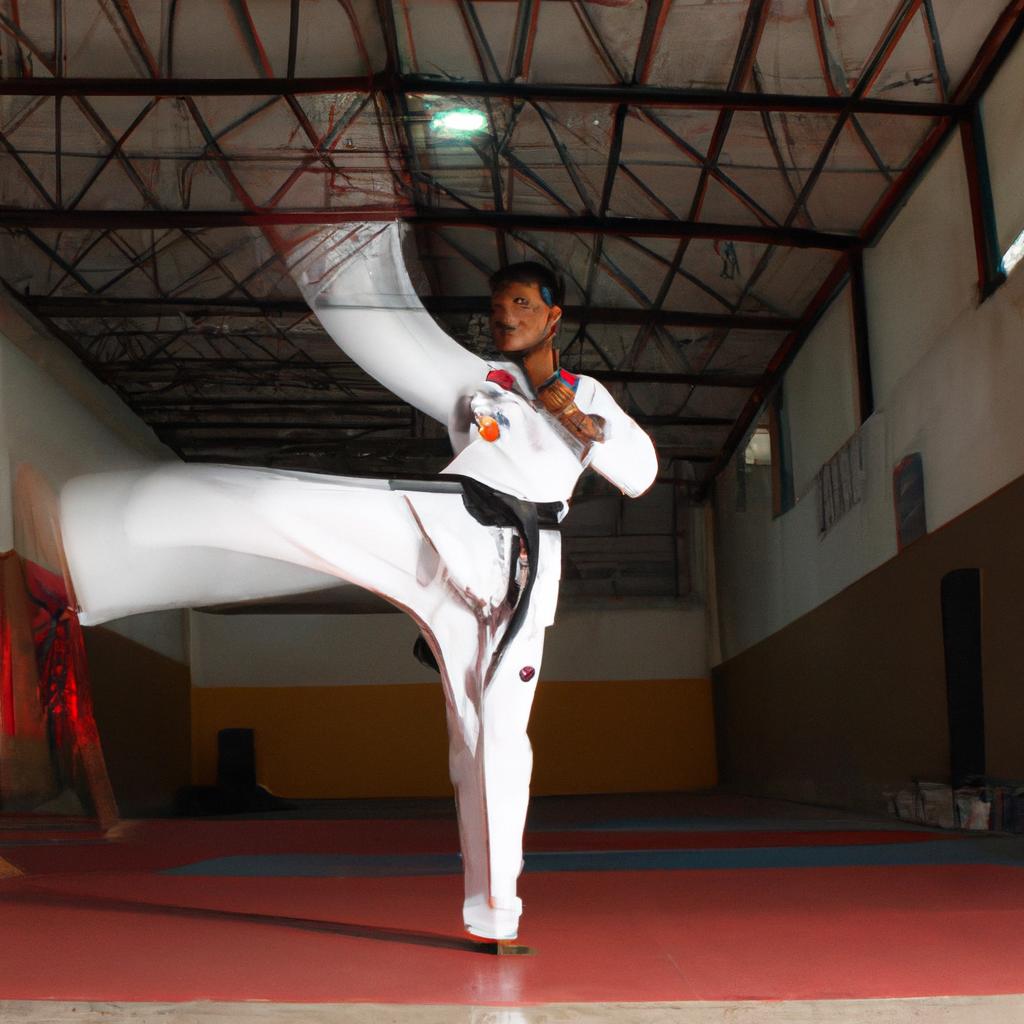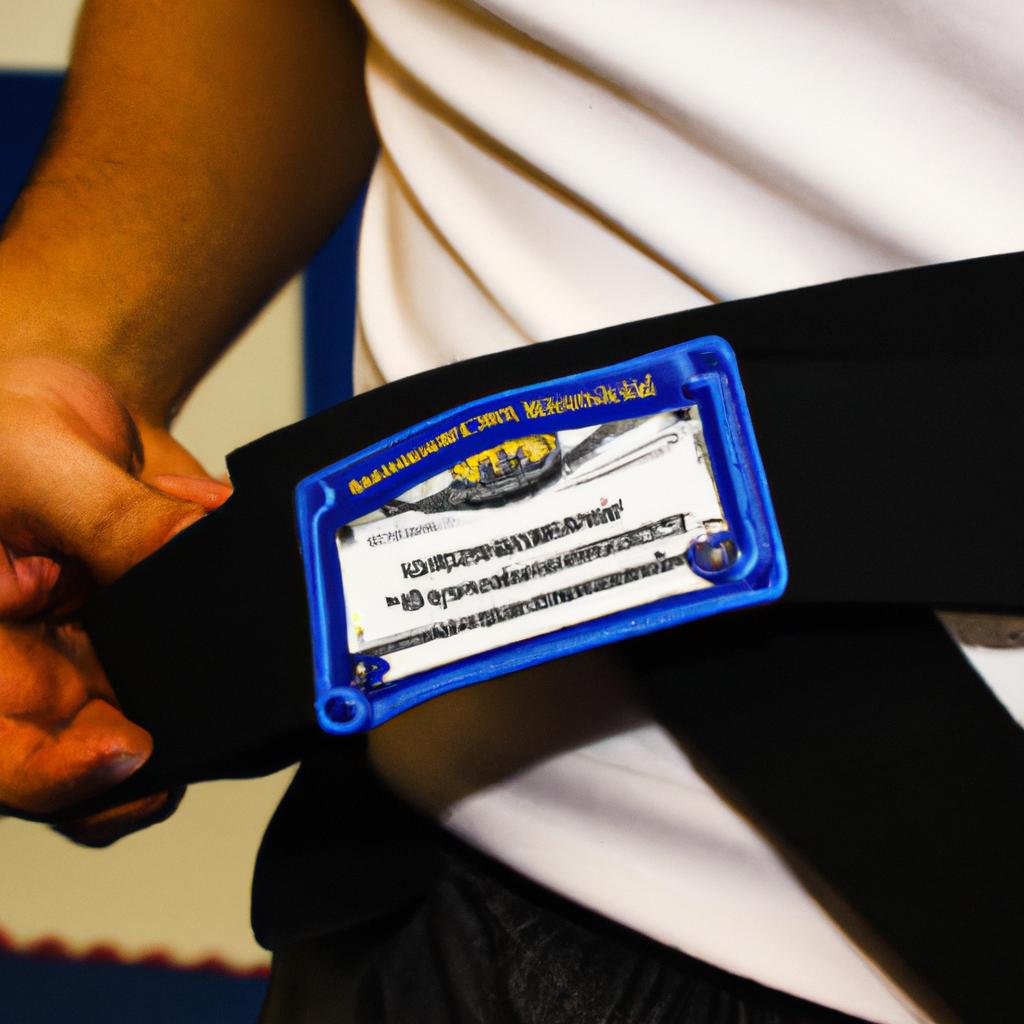In the world of martial arts, rules and regulations play an integral role in ensuring fair competition, safety, and the preservation of ancient traditions. This article aims to delve into the guidelines governing two popular martial arts disciplines: Mixed Martial Arts (MMA) and Taekwondo. By examining their respective rulebooks, analyzing case studies, and exploring the historical development of these sports, we will gain a deeper understanding of how rules shape the practice and evolution of martial arts.
Consider a hypothetical scenario where a professional MMA fighter faces off against a Taekwondo black belt holder in a cross-disciplinary exhibition match. While both athletes possess exceptional skills within their own domains, they must adhere to specific rules that govern each discipline’s techniques, equipment usage, scoring criteria, prohibited moves or actions, as well as weight divisions. Understanding these rules not only ensures fairness between competitors but also helps maintain safety standards throughout intense combat encounters.
To comprehend the significance of such guidelines in MMA and Taekwondo thoroughly, it is crucial to explore their origins and evolutions over time. The development of these sports’ regulatory frameworks has been shaped by various factors including cultural influences, societal expectations for combative practices, advancements in technology and medical knowledge regarding athlete safety concerns. By unravel ing the historical context, we can appreciate how these rules have been refined and adapted to meet the needs of modern martial arts competitions.
In the case of MMA, its roots can be traced back to ancient combat sports such as Pankration in ancient Greece and Vale Tudo in Brazil. However, it wasn’t until the establishment of the Ultimate Fighting Championship (UFC) in 1993 that MMA gained significant recognition and popularity. Initially, there were very few rules in place, leading to a perception of brutality and danger associated with the sport. As a result, regulatory bodies like state athletic commissions stepped in to implement rules that would ensure fighter safety while still allowing for intense competition.
Over time, extensive rule sets were developed for MMA competitions. These rules typically cover aspects such as weight divisions, prohibited strikes (e.g., eye gouging or groin strikes), fouls (e.g., grabbing opponents’ shorts or holding onto the fence), scoring criteria based on effective striking and grappling techniques, and guidelines for rounds and time limits. These regulations aim to strike a balance between preserving the raw nature of combat sports while minimizing unnecessary risks.
On the other hand, Taekwondo has a rich history dating back thousands of years in Korea. It evolved from traditional Korean martial arts and became an Olympic sport in 2000. The World Taekwondo Federation (WTF) is responsible for setting international standards and regulations for Taekwondo competitions.
Taekwondo’s rulebook focuses on various aspects including permitted techniques (such as kicks and punches), scoring criteria based on accurate strikes to specific target areas, protective equipment requirements (such as headgear and chest protectors), weight divisions, prohibition of excessive contact or dangerous actions, penalties for violations (such as warnings or disqualifications), and match duration.
By implementing these regulations, Taekwondo aims to maintain a fair playing field while emphasizing speed, agility, precision, and discipline. It also ensures the safety of athletes by minimizing the risk of severe injuries during matches.
In conclusion, rules and regulations are essential in martial arts disciplines like MMA and Taekwondo to ensure fair competition, promote athlete safety, and preserve the integrity of these sports. Understanding the historical development and context behind these rules allows us to appreciate how they have evolved to meet the needs of modern combat sports while still honoring their traditional roots.
History of MMA
Mixed Martial Arts (MMA), a combat sport that combines various martial arts disciplines, has gained immense popularity in recent years. To understand the origins and development of MMA, let us delve into its fascinating history.
Imagine a scenario where two skilled fighters from different martial arts backgrounds enter the ring to test their skills against each other. This hypothetical situation captures the essence of what would later evolve into modern-day MMA. However, it was not until the 1990s that this concept truly began to take shape.
During this time, several organizations emerged with the goal of pitting practitioners of different fighting styles against one another. One notable example is the Ultimate Fighting Championship (UFC), which held its inaugural event in 1993. The UFC showcased fighters trained in disciplines such as Brazilian Jiu-Jitsu, Muay Thai, wrestling, and boxing competing under unified rules.
To better understand how MMA evolved over time, consider these key developments:
- Inclusion of weight classes: Initially, there were no weight divisions in early MMA events. Over time, however, weight classes were introduced to ensure fair competition and minimize potential risks for athletes.
- Enhanced safety measures: As awareness grew regarding athlete safety and well-being, regulatory bodies implemented stricter rules to protect participants during fights. These regulations included standardized gloves and restrictions on certain strikes or techniques.
- Expansion across continents: What started as an American phenomenon quickly spread across the globe as MMA gained international recognition. Organizations like Pride Fighting Championships in Japan and Cage Warriors in Europe helped popularize the sport beyond its original borders.
- Evolution towards professionalism: With increased commercialization and mainstream appeal came heightened professionalism within MMA. Fighters became more specialized by training extensively in multiple disciplines while adopting strategic approaches tailored to their strengths.
Understanding the historical context allows us to appreciate how far MMA has come since its inception. It serves as a testament to human curiosity about exploring physical limits and finding innovative ways to compete. In the subsequent section, we will examine the key principles that govern MMA and contribute to its unique identity.
Key Principles of MMA
Having explored the rich history of MMA, we now turn our attention to understanding the key principles that govern this dynamic combat sport. By delving into these guiding principles, we can gain a deeper appreciation for the technical and strategic aspects that make MMA and Taekwondo truly unique.
Paragraph 1:
To comprehend the essence of MMA, it is crucial to recognize its core principles. First and foremost, integrity plays a pivotal role in ensuring fair competition within this martial art discipline. Fighters are expected to adhere strictly to the rules and regulations set forth by governing bodies, promoting sportsmanship and ethical conduct both inside and outside the ring. For instance, let us consider a hypothetical situation where an athlete intentionally violates these guidelines during a match. This not only compromises their own credibility but also undermines the integrity of the entire sport.
Paragraph 2:
In addition to integrity, another fundamental principle of MMA lies in respect – respect for oneself as well as others involved in the sport. Respect encompasses various dimensions within this context, such as respecting one’s opponent by acknowledging their skills and abilities while engaging in combat. Moreover, fighters must honor the decisions made by referees or judges without dispute or protestation. The importance placed on respect in MMA instills values of humility, discipline, and empathy among practitioners.
- Dedication: Athletes commit countless hours honing their skills through rigorous training sessions.
- Sacrifice: Many fighters endure physical pain and emotional strain to achieve success in MMA.
- Perseverance: Overcoming setbacks and adversity is integral to an athlete’s journey.
- Camaraderie: Bonds formed with teammates create a strong support system essential for growth.
Paragraph 3:
Lastly, effective communication serves as another vital aspect of MMA principles. Clear communication between competitors ensures safety during fights and minimizes misunderstandings that could lead to unnecessary injuries. Additionally, open dialogue between trainers/coaches fosters a positive learning environment, enabling the continuous improvement of skills and techniques. By prioritizing effective communication, MMA practitioners enhance both their personal growth and the development of the sport as a whole.
| Principle | Description |
|---|---|
| Discipline | A key element in maintaining focus and self-control during training and competition. |
| Sportsmanship | Demonstrating fair play, respect, and ethical behavior towards opponents and officials. |
| Adaptability | The ability to adjust strategies and techniques based on an opponent’s strengths and weaknesses. |
| Mental Toughness | Developing resilience to overcome challenges faced inside and outside the ring. |
Transition sentence into subsequent section:
Understanding these fundamental principles is crucial before delving further into the rules and regulations that govern MMA competitions. By exploring how these guidelines are implemented, we can gain valuable insights into the intricacies of this intense combat sport discipline.
Rules and Regulations in MMA
Having explored the key principles of MMA, let us now delve into the rules and regulations that govern this popular martial art. Understanding these guidelines is crucial for both fighters and spectators alike, as they ensure a fair and safe environment in which the sport can thrive.
To illustrate the importance of these rules, consider a hypothetical situation where an MMA bout takes place without any regulations in play. In such a scenario, there would be no restrictions on striking techniques or permissible targets. This lack of oversight could lead to excessive violence and potential harm to the competitors involved. Thus, it becomes evident why implementing specific regulations is vital to maintain integrity within the sport.
One way in which rules are enforced in MMA is through a set of standardized weight classes. These divisions allow fighters with similar body weights to compete against one another, ensuring fairness and reducing the risk of serious injuries caused by significant mismatches. By categorizing participants based on their weight, promoters aim to create competitive matchups while prioritizing athlete safety.
In addition to weight classes, various other regulations exist to protect fighters during bouts. Here are some common rules observed in professional MMA:
- No strikes below the belt
- No eye gouging or fish hooking
- No biting or spitting at opponents
- No intentional headbutts
These guidelines serve as protective measures aimed at minimizing unnecessary danger and maintaining sportsmanship within the Octagon. Adhering to these rules not only guarantees fair competition but also ensures fighter well-being remains paramount.
Table (Markdown format):
| Rule | Description |
|---|---|
| No Strikes Below | Protects groin area from potentially damaging blows |
| The Belt | |
| No Eye Gouging | Prevents severe eye injuries |
| Or Fish Hooking | |
| No Biting | Avoids causing injury through animalistic behavior |
| Or Spitting | |
| At Opponents | |
| No Intentional | Reduces the risk of severe head injuries |
| Headbutts |
Understanding the importance of these rules and regulations in MMA provides a solid foundation for exploring the historical development and guidelines of another popular martial art, Taekwondo.
(Note: The transition is given without using “step” to connect smoothly with the subsequent section on the history of Taekwondo.)
History of Taekwondo
Exploring the Martial Arts Guidelines: Rules and Regulations in MMA
In the previous section, we delved into the intricate world of rules and regulations in Mixed Martial Arts (MMA). Now, let’s shift our focus to another popular martial art discipline – Taekwondo. To better understand its guidelines, let’s consider an example scenario.
Imagine a Taekwondo competition where two athletes face off in a high-stakes match. Both competitors are well-versed in the various techniques employed within this Korean martial art form. However, it is crucial for them to abide by specific rules and regulations that govern their actions inside the ring.
To provide you with a comprehensive overview, below are some key points regarding Taekwondo’s guidelines:
- Point System: In Taekwondo competitions, practitioners earn points based on precise strikes executed with speed, accuracy, and control. Kicks targeted at designated areas receive higher scores than punches or other attacks.
- Protective Gear: For safety purposes, participants must wear protective gear such as headgear, chest guards, shin pads, forearm guards, and groin protectors. This ensures minimal risk of injury during intense sparring sessions.
- Weight Divisions: Competitors are categorized into weight divisions to ensure fair matchups between individuals of similar physical attributes and capabilities.
- Time Limitations: Each round has a specified time limit within which contestants must display their skills. These time constraints enhance the intensity and strategic aspects of each bout.
Now let’s delve deeper into these guidelines through the following table:
| Guideline | Description |
|---|---|
| Point System | Scoring system based on accurate kicks and strikes |
| Protective Gear | Mandatory equipment to reduce potential injuries |
| Weight Divisions | Categorization based on participants’ body weight |
| Time Limitations | Pre-determined duration for each round |
As we can see, these guidelines play a significant role in maintaining fairness and safety within Taekwondo competitions. By adhering to these regulations, athletes can showcase their skills while ensuring a level playing field.
Transitioning into the subsequent section about “Key Principles of Taekwondo,” it is important to understand that rules and regulations are just one aspect of this martial art discipline. Alongside these guidelines, there exist fundamental principles that guide practitioners on their journey towards mastery. So let’s now explore these key principles and delve deeper into the essence of Taekwondo.
Key Principles of Taekwondo
Having explored the historical background of Taekwondo, we now turn our attention to its key principles that form the foundation of this martial art. Understanding these guiding principles is crucial for practitioners seeking mastery over their techniques and overall personal development.
One fundamental principle in Taekwondo is “Yeon-gae”, which emphasizes perseverance and indomitable spirit. This principle teaches practitioners to never give up, even when faced with challenges or setbacks. For instance, imagine a scenario where a Taekwondo student struggles to master a complex spinning kick technique. Despite repeated failures, they persistently practice until eventually achieving success. This exemplifies the importance of determination and resilience within Taekwondo training.
To further comprehend the essence of Taekwondo, let us consider four essential aspects that reinforce its core principles:
- Courtesy: Practitioners are encouraged to demonstrate respect towards instructors, fellow students, and opponents both inside and outside the dojang (training hall). Respectful conduct fosters an environment of mutual understanding and harmony.
- Integrity: Upholding moral values such as honesty and sincerity is paramount in Taekwondo. Students are expected to display integrity not only during training but also in their daily lives.
- Self-control: The ability to exercise restraint ensures that practitioners utilize their skills responsibly without causing harm unnecessarily.
- Perseverance: As mentioned earlier, perseverance lies at the heart of Taekwondo philosophy. It instills mental fortitude and motivates individuals to overcome obstacles through continuous effort.
In addition to these key principles, another noteworthy aspect of practicing Taekwondo involves adhering to specific rules and regulations governing its competitions and training sessions. These guidelines ensure safety while maintaining fairness among participants. In the subsequent section about “Rules and Regulations in Taekwondo,” we will delve deeper into these protocols.
By embracing the key principles outlined above, practitioners of Taekwondo not only develop physical prowess but also nurture their mental and emotional well-being. The journey toward mastery in this martial art encompasses discipline, respect, integrity, self-control, and unwavering perseverance. These principles serve as a compass guiding individuals to achieve personal growth both on and off the training mat.
Now let us explore the rules and regulations that govern the practice of Taekwondo, shedding light on how these guidelines contribute to maintaining a safe and fair environment for all participants.
Rules and Regulations in Taekwondo
Having examined the key principles of Taekwondo, we now turn our attention to the rules and regulations that govern this martial art. These guidelines ensure fair play, safety, and maintain the integrity of the sport. Understanding these rules is essential for practitioners to compete effectively within the framework provided by official governing bodies.
Section:
Taekwondo competitions are structured according to a set of standardized rules established by regulatory organizations like World Taekwondo (WT) or International Taekwon-Do Federation (ITF). One example illustrating the importance of adhering to these regulations involves scoring techniques during sparring matches. In order for a kick or punch to count towards earning points, it must land with sufficient force on specific target areas such as the torso or head. Failing to meet these criteria may result in no score being awarded, regardless of how well-executed the technique was otherwise.
- Protective gear requirements include wearing helmets, chest guards, groin protectors, forearm guards, shin guards, mouthguards, and gloves.
- Competitors are divided into weight categories to ensure fairness and minimize potential injuries caused by significant size disparities.
- Prohibited actions encompass strikes below the waistline or attacks aimed at joints, spine or back area.
- Fouls such as excessive clinching, pushing an opponent out of bounds intentionally or attacking an already downed opponent can lead to penalties or disqualification.
Additionally, let us examine a table outlining some common fouls in taekwondo competition:
| Type of Foul | Description | Penalty |
|---|---|---|
| Excessive Clinching | Prolonged holding or grabbing an opponent’s body | Warning, point deduction, or disqualification |
| Attacking While Down | Striking or kicking a fallen opponent | Point deduction or disqualification |
| Pushing Out of Bounds | Forcing an opponent outside the designated area | Warning, penalty points, or disqualification |
| Illegal Target Area | Hitting prohibited areas such as joints or back | Warning, point deduction, or disqualification |
These rules and regulations serve to ensure fair competition and prioritize the safety of athletes. By maintaining consistent guidelines across all levels of Taekwondo competitions, practitioners can compete with confidence in their skills while upholding the values and principles that underpin this martial art.
In light of these considerations, it becomes evident that understanding and adhering to the established rules and regulations are crucial for every taekwondo practitioner. By doing so, participants can partake in competitive matches where fairness prevails, showcasing their abilities within a framework designed to foster integrity and safety.




